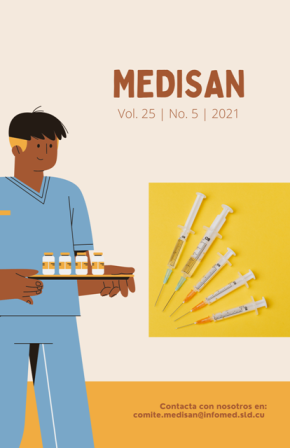Clinical epidemiological characterization of children with recurrent wheezing
Keywords:
pediatrics, children, recurrent wheezing, asthma.Abstract
Introduction: The recurrent wheezing in infants and preschool children are frequent reason of visit in pediatrics.
Objective: To characterize children with recurrent wheezing from the clinical and epidemiologic points of view.
Methods: An observational, longitudinal and prospective investigation of 140 children with recurrent wheezing, assisted in the Respiratory Service of Dr. Antonio María Béguez Cesar Southern Teaching Children Hospital was carried out in Santiago de Cuba, from January, 2016 to December, 2018.
Results: There was a prevalence of the male sex (57.1 %), the patients of urban origin (62.1 %) and 28 de Septiembre health area as that of more incidence (42.7 %). The average age was of 1 year and 5 months, approximately. The children included in the interval from 6 to 11 months and 29 days were the most affected (28.6 %). Among the municipalities, Guamá contributed the higher number of cases (33.9 %). There was no statistical association between the prediction index of asthma and the sex; however, it was higher among males (19.3 %).
Conclusions: The clinical and epidemiologic characteristics of the patients with recurrent wheezing of this case material don't differ from the world epidemiologic context, being an entity of frequent observation in the pediatrics services.
Downloads
References
2. Barrett KE, Barman SM, Boitano S, Brooks HL. Fisiología respiratoria. En: Tratado de fisiología médica. 23 ed. China: McGraw-Hill Companies; 2010. V1. p.587-607.
3. Shakur S. Bronchial Asthma. In: Illustrated textbook of Pediatrics. 2ed. New Delhi: The Health Sciences Publisher; 2015. p.331-48.
4. Ashok P, Sarnaik, Sabrina M, Heidemann, Jeff A. Clark. Respiratory Pathophysiology and Regulation. In: Kliegman RM, Stanton BF, Schor NF, Geme J, Behrman RE. WE Texbook of Pediatrics. 20 ed. Philadelphia: Elsevier/Saunders; 2015.V2. p.1981-98.
5. Valcárcel Vidal I, Razón Behar R, Ramos Carpente LT, Cantillo Gámez HM, Reyes López MC, De Armas Morales I, et al. Sibilancias recurrentes en el niño. Rev Cubana Pediatr. 2008 [citado 05/07/2019]; 80 (4): 1-10. Disponible en: http://scielo.sld.cu/scielo.php?script=sci_arttext&pid=S0034-75312008000400001&lng=es
6. Szulman GA, Freilij H, Behrends I, Gentile A, Mallol J. Sibilancias recurrentes: prevalencia y factores asociados en lactantes de Buenos Aires, Argentina. Bol Med Hosp Infant Mex. 2017 [citado 06/08/2019]; 74 (6): 419-26. Disponible en: https://www.elsevier.es/es-revista-boletin-medico-del-hospital-infantil-401-articulo-sibilancias-recurrentes-prevalencia-factores-asociados-S1665114617301338
7. Pérez Yarza EG, Sardón Prado O, Korta Murua J. Sibilancias recurrentes en menores de tres años: evidencias y oportunidades. An Pediatr (Barc). 2008 [citado 06/08/2019]; 69 (4): 369-82. Disponible en: https://www.analesdepediatria.org/es-sibilancias-recurrentes-menores-tres-anos-articulo-S1695403308723683
8. Vásquez LM, Olaya M, Cleves D, Ramírez Zuluaga LF, Serrano C. Caracterización de los niños menores de cinco años con sospecha de enfermedades alérgicas. Rev. alerg. Méx. 2018 [citado 06/08/2019]; 65 (1): 52-60. Disponible en: http://www.scielo.org.mx/scielo.php?script=sci_arttext&pid=S2448-91902018000100052&lng=es
9. O'Connor GT, Lynch SV, Bloomberg GR, Kattan M, Wood RA, Gergen PJ, et al. Early-life home environment and risk of asthma among inner-city children. J Allergy Clin Immunol. 2018 [citado 18/08/2019]; 141 (4): 1468-75. Disponible en: https://pubmed.ncbi.nlm.nih.gov/28939248/
10. Cuba. Ministerio de Salud Pública. Anuario Estadístico de Salud, 2016. La Habana: MINSAP; 2017.
11. González Marín ÁT, Cabrera Valldaura Md, González Iglesias Á, González Iglesias L, Triana Toledo Y. Comportamiento de la sibilancia en niños menores de cinco años de la provincia Sancti Spíritus. Rev. Inf. Cient. 2018 [citado 26/08/2019]; 97 (3): 538-47. Disponible en: http://www.revinfcientifica.sld.cu/index.php/ric/article/view/1932
12. Global Initiative for Asthma. GINA Global Strategy for Asthma Management and Prevention. Chicago: GINA; 2016.
13. Restrepo Gualteros SM, Villamil Osorio M, Rodríguez Martínez CE. Fenotipos del asma en Pediatría. Rev Colom Neum. 2015 [citado 27/09/2019]; 27 (3): 254-57. Disponible en: https://revistas.asoneumocito.org/index.php/rcneumologia/article/view/83
14. Al Shamrani A, Bagais K, Alenazi A, Alqwaiee M, Al Harbi AS. Wheezing in children: Approaches to diagnosis and management. International Journal of Pediatrics and Adolescent Medicine. 2019; 6(2):68-73.
15. Silva Rojas M, Martínez Milián Y. Índice predictivo de asma y factores asociados en menores de cinco años con sibilancias recurrentes. Rev. electrón. Zoilo. 2016 [citado 20/10/2019]; 41 (1). Disponible en: http://revzoilomarinello.sld.cu/index.php/zmv/article/view/524
16. Barros de Sousa R, Medeiros D, Sarinho E, Rizzo JÂ, Rêgo Silva A, Dela Bianca AC. Risk factors for recurrent wheezing in infants: a case-control study. Rev Saúde Pública. 2016 [citado 20/10/2019]; 50 (15): 1-8. Disponible en: https://www.scielo.br/j/rsp/a/qdGqKvfxHDgQxCL3tfvwk3H/?lang=en
17. Castro Rodriguez JA, Custovic A, Ducharme FM. Treatment of asthma in young children: evidence-based recommendations. Asthma Res Pract. 2016; 2: 5.
18. Aguilera Zamarroni F, Huerta López JG. Sibilancias tempranas recurrentes y factores de riesgo para el desarrollo futuro de asma. Alerg Asma Inmunol Pediatr. 2016 [citado 22/10/2019]; 25 (1): 12-23. Disponible en: https://www.medigraphic.com/pdfs/alergia/al-2016/al161c.pdf
19. Callén Blecua M, Mora Gandarillas I. Manejo integral del asma. En: AEPap (ed.). Curso de Actualización Pediatría 2017. Madrid: Lúa Ediciones 3.0; 2017. p. 503-12.
20. Úbeda Sansano MI. Tratamiento de las sibilancias recurrentes. Rev Pediatr Aten Primaria. 2017; 19 (Supl. 26):27-34.
Published
How to Cite
Issue
Section
License
All the articles can be downloaded or read for free. The journal does not charge any amount of money to the authors for the reception, edition or the publication of the articles, making the whole process completely free. Medisan has no embargo period and it is published under the license of Creative Commons, International Non Commercial Recognition 4.0, which authorizes the copy, reproduction and the total or partial distribution of the articles in any format or platform, with the conditions of citing the source of information and not to be used for profitable purposes.





